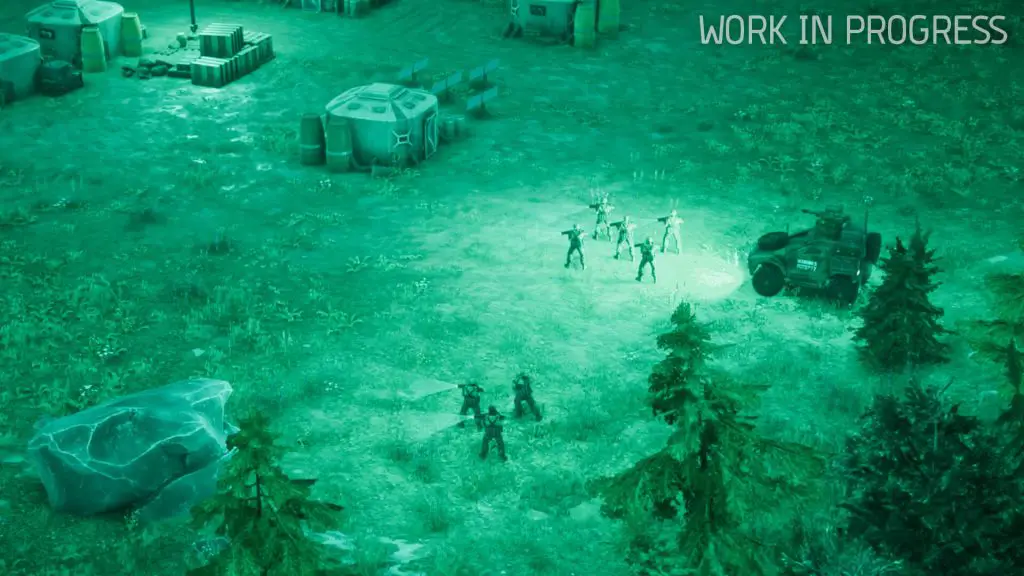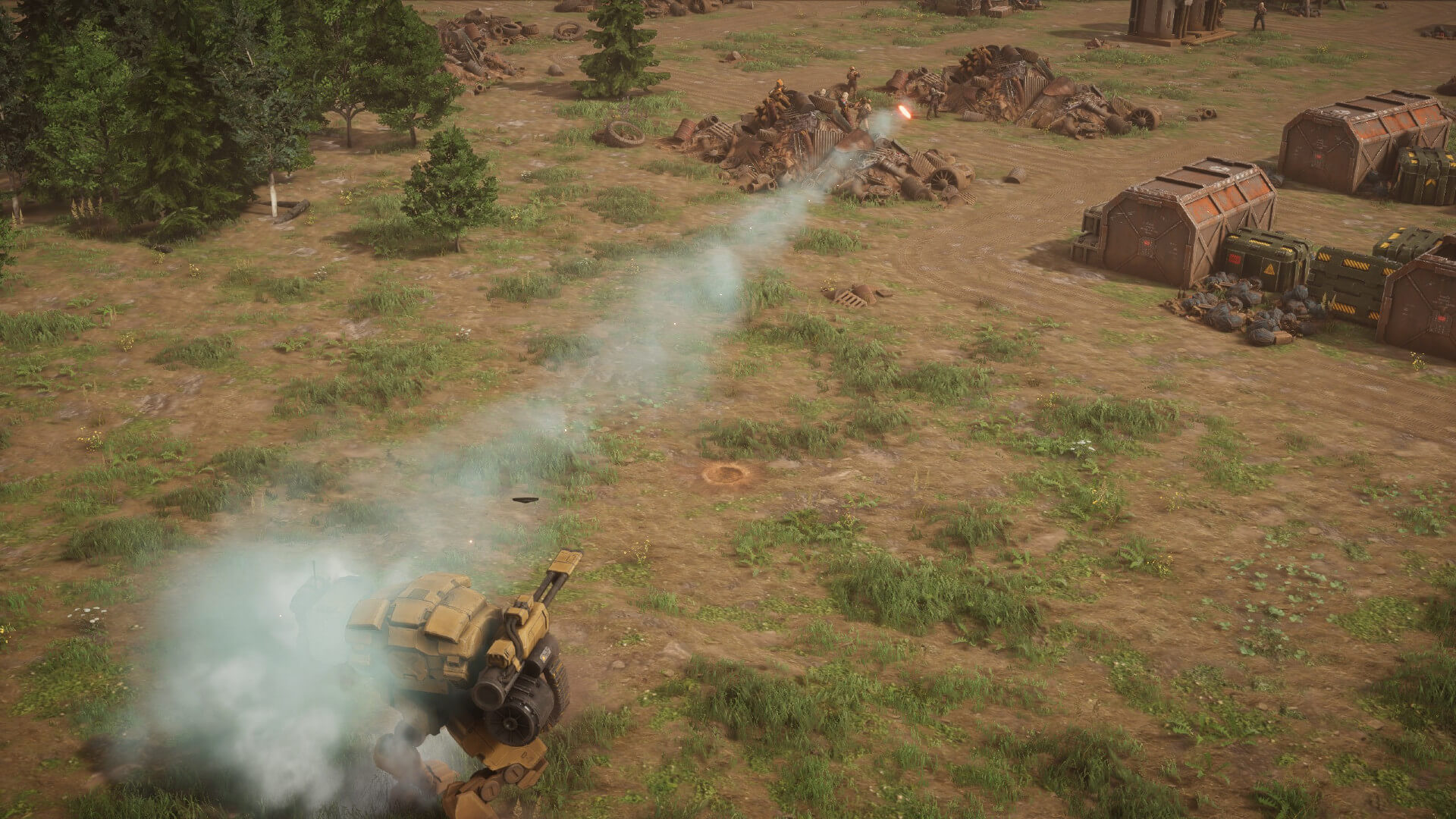I’m picking up where I left off some time ago, continuing to keep track of updates on MENACE, the brand-new strategy RPG from Overhype Studios, the developers behind the acclaimed mercenary simulator RPG Battle Brothers.
These updates come regularly through the detailed devlogs posted on the game’s Steam page. So far, a wealth of information has already been shared, which I’ve gathered across previous articles:
- How the Strategy Layer works.
- New details about the combat system.
- Information on weapons and their associated skills.
- Squad Leaders, Stats, Supplies, and Equipment.
- Suppression And Ship Improvements.
- How Perks And Promotions Work.
- The Pirate Faction.
Today, however, after stepping back a bit due to work and personal commitments, I’m bringing together four dev diaries into a single article. We’ll cover action points, mission types, how discipline and the soldiers’ morale system work, and how weather impacts the combat scenarios.
Action Points and Attack Calculation
In Dev Diary #11 for MENACE they explain how action points (AP) govern your units’ movements and actions, as well as how the game’s intricate combat calculations determine the outcomes of firefights.
Unlike many modern turn-based strategy games that favor a simplified two-action system, MENACE sticks to a more traditional action point model, offering greater tactical depth. Each unit on the battlefield begins with 100 AP per turn. Actions—such as moving, firing weapons, or using skills—consume AP according to their complexity and intensity.
For example, firing a standard squad weapon costs 40 AP, while heavier special weapons like rocket launchers demand 60 AP, limiting their use to once per turn.
Environmental factors also impact movement costs, meaning your unit’s efficiency changes depending on the terrain, movement type, and conditions like suppression, while vehicles require AP not only for movement but also for actions like turning.
The diary then shifts to describe the complex mechanics behind attacks in MENACE, giving you a clear understanding of how hits, misses, and damage are determined. Attacks begin with spending the necessary AP to perform a skill, like firing a weapon. Hit chances are calculated from the attacker’s base accuracy, modified by factors such as weapon-specific stats, distance to the target, cover, lighting conditions, and the stances of both attacker and defender.
For example, firing an assault rifle (K-PAC) six tiles away from an enemy would involve a significant accuracy penalty because the weapon’s ideal range is only four tiles, resulting in a reduced final hit chance.
Combat is resolved through multiple layers: after calculating hit chances, the number of shots per attacker is factored in. Each shot is rolled individually, meaning outcomes are variable. Even mid-attack, conditions can change if early hits suppress or pin the enemy, altering later shots’ effectiveness.
Beyond simply hitting, each bullet must penetrate armor to inflict hitpoint damage. Penetration values decrease over distance, and armor effectiveness wears down as it absorbs hits. In the example provided, a Marine Squad firing at a Pirate Scavenger Squad managed to land 12 shots, of which 7 hit, and 5 penetrated the armor. Effective armor and hitpoint damage also decline with distance, illustrating how positioning and engagement ranges are critical considerations for you.
Armor durability is managed on a squad-wide basis, not individually per soldier, ensuring that the status of the group as a whole reflects the attrition it suffers. Meanwhile, non-penetrating shots contribute to wearing down armor, making enemies more vulnerable to future attacks.

Mission types
In Dev Diary #12, you are introduced to the variety of mission types that expand the tactical depth beyond the simple goal of eliminating all enemies. Missions in MENACE are fought on procedurally generated 3D maps and are part of larger “Operations,” meaning each mission is a stepping stone in a broader campaign. Your success in these missions is measured not only by victory but also by performance factors such as speed and casualties, rewarding you with loot and promotion points for your squad leaders and pilots.
The diary outlines several key mission types you can expect to face:
- In Capture Area missions, your goal is to swiftly seize and control designated zones before the enemy does. Both you and enemy forces deploy from opposite ends of the map, racing to occupy and control critical capture areas situated near the center. Each capture zone has a set number of “capture tickets,” and the more units you place within the zone, the faster you can claim it. However, enemy presence will stall your progress, so clearing the area of opponents is essential. Speed is the decisive factor here, urging you to use transport vehicles, sprint perks, and movement-enhancing items to outpace the opposition.
- Hold Ground missions shift the dynamic to defense. Here, you must defend a central area from waves of enemy forces arriving from all directions. Enemy reinforcements are unlimited, making it critical for you to maintain strong, flexible defenses around the objective. The mission is lost if enemy units occupy the defended zone for too long, reducing its ticket counter to zero. Success hinges on strategic positioning, swift reaction to breakthroughs, and heavy use of suppressive fire to slow advancing enemies before they can entrench themselves.
- The Sabotage mission type emphasizes stealth and speed over brute force. You are tasked with reaching target zones and executing sabotage actions without necessarily engaging every enemy on the map. Enemy patrols start unaware of each other’s discoveries, meaning you can slip past many forces if you avoid detection. When combat does start, reinforcements and local units will react independently, creating opportunities to bypass heavy resistance. Winning these missions depends on careful scouting, clever movement, and rapid exfiltration after completing your objectives.
- Rescue Civilians missions introduce a humanitarian aspect. Civilians or VIPs must be extracted from enemy-controlled locations. Once a unit reaches a civilian, you gain control of them and must guide them to safety at the southern border. Enemy forces guarding the captives are relatively weak, but once hostilities commence, powerful enemy reinforcements will rush to cut off your escape routes. Managing this requires synchronized rescues to prevent isolation of any group and heavy use of suppressive fire and transport vehicles to expedite extraction before enemies can intercept.
- Finally, Base Assault missions demand the direct confrontation of heavily fortified enemy positions. In these missions, you must destroy or rout a significant percentage of enemy forces entrenched in strongholds fortified with bunkers, guard towers, automated turrets, and minefields. Success requires meticulous planning: reconnaissance to identify threats, concentrated assaults to punch through defenses, and the right equipment like rocket launchers and grenades to breach structures. Choosing the right point of attack and maintaining momentum is critical to overwhelming the defenders before their fortifications turn the tide against you.
Throughout the diary, it is emphasized that each mission type demands a distinct approach and tailored strategies. You must adapt your squads, equipment, and tactics to the mission’s unique challenges rather than relying on a one-size-fits-all method.
Discipline and Morale
In Dev Diary #13, the developers delve into one of the most critical yet often overlooked aspects of battlefield simulation: Discipline and Morale. You are shown how the game models the psychological dynamics of combat, ensuring that battles feel not only physically intense but also mentally grueling, much closer to real-world conflicts than typical video game skirmishes.

The diary explains that in real combat, most engagements end not with total destruction, but when one side loses the will to fight. Drawing inspiration from historical casualty rates—where losses rarely exceed 30%—MENACE aims to make morale as decisive a factor as sheer firepower. You are encouraged to win battles by breaking the enemy’s spirit, not just through annihilation.
Discipline serves as a foundational stat representing a unit’s training, motivation, and audacity. This single metric, rated from 1 to 100, encapsulates how well a unit holds under pressure. High-discipline units shrug off the stress of battle more effectively, suffering less suppression from attacks and nearby impacts.
For example, a squad with 60 Discipline only experiences 40% of the suppression effects they would otherwise receive. Boosting Discipline temporarily, such as through combat stimulants, can give your units the edge in critical engagements by resisting enemy suppression better.
Meanwhile, Morale directly measures a unit’s willingness to continue fighting. It is dynamically tied to a unit’s initial Discipline but also scales with damage taken during combat. When morale drops below certain thresholds, a unit’s behavior changes dramatically:
- Unaffected units function normally.
- Wavering units suffer a 20% penalty to accuracy and action points, and they act last in the turn order, severely hampering their effectiveness.
- Fleeing units are out of your control, retreating away from enemies, and possibly disbanding if they are heavily damaged (a condition that only applies to enemy units, never your own).
You must monitor morale carefully because it fluctuates with a range of battlefield events. Damage, losses, nearby allies fleeing, and failed objectives all sap morale. Conversely, eliminating enemy forces, causing vehicle malfunctions, and completing mission goals bolster morale.
Morale is also impacted by a unit’s current health. A unit’s maximum morale decreases proportionally with its remaining hit points. Thus, a squad at half strength also has half of its initial morale ceiling, making it much easier to push them into wavering or fleeing states. Morale regenerates over time, recovering 33% of the dynamic maximum each turn, which means you must strike decisively if you aim to rout enemies rather than grind them down slowly.
The diary offers a tactical advice: use a “shock and awe” strategy to rout enemy forces efficiently. Delivering rapid, overwhelming blows—destroying or heavily damaging multiple enemy squads in quick succession—can cause a cascading morale collapse among nearby enemies. Conversely, merely wearing down enemy units over many turns often allows them time to recover their morale and fight on.
However, you are warned that not every enemy will be vulnerable to morale mechanics. Certain foes will fight to the last man, requiring different strategies that do not rely on breaking their will.
Lighting and Weather
In Dev Diary #14, developers reveal how lighting and weather systems will dramatically affect the battlefield, offering you a first look at how environmental conditions enhance both the atmosphere and tactical depth of the game. By mirroring real-world challenges like night operations, sandstorms, and rain, MENACE aims to create a more immersive and varied combat experience every time you deploy.
The Time of Day system introduces four distinct lighting scenarios: Dawn, Day, Dusk, and Night. Each setting has unique visual characteristics designed to immediately convey the time of day while enriching the atmosphere of the biomes. Clear and overcast versions exist for each (except night), ensuring every battle feels visually different. Daylight battles will be the most common, offering bright, sharp colors and no gameplay modifiers. However, fighting at dusk or dawn adds an evocative mood with low, colored lighting and long shadows, helping to keep the battlefield visually dynamic.

Night introduces major gameplay effects. At night, units suffer a four-tile reduction in vision range, a 50% drop in detection capability, and a 20% reduction in accuracy. This forces battles into closer, more lethal encounters where visibility is limited and reaction times are crucial. To help manage night battles, you can equip troops with night vision gear, significantly reducing or eliminating these penalties and restoring much-needed operational efficiency under darkness. Vehicles also automatically activate headlights, adding eerie, dynamic lighting to the battlefield.
The Weather System layers further complexity onto missions. Early examples include:
- Light Rain: Adds visual and ambient atmosphere but no gameplay changes.
- Heavy Rain/Thunderstorms: Reduce vision range, making battlefield awareness more challenging.
- Sandstorms (Desert Biomes): Severely reduce vision and accuracy while also slowing down movement. Fighting in sandstorms will require careful planning and the right equipment.
- Blizzards (Snow Biomes): Similarly reduce vision and slow movement, compounding the difficulty of maintaining formations and executing precise tactics in arctic conditions.
Each weather condition comes with carefully crafted visual effects and ambient sounds, ensuring you feel the environment’s impact both in gameplay and atmosphere. Additionally, MENACE plans to introduce even more unique environmental effects on alien planets, such as extreme temperatures affecting weapon efficiency, gravitational anomalies, and possibly even exotic hazards like energy fields.
The diary emphasizes that while these environmental factors add realism, they are not mere aesthetic additions; they will directly influence your tactical choices.
For instance, a sandstorm could allow you to approach enemy positions more easily but make coordinating an effective attack more difficult. Conversely, night battles without proper preparation could cripple your forces, while equipped night-fighters might dominate under cover of darkness.
With that, I’m done. See you in the next article, where we’ll dive into another enemy faction featured in the game, exploring its arsenal and battlefield tactics. Just a reminder: MENACE is currently in development and will launch in Early Access on PC during Q3 2025.







